|
Spitfire Mk.IXb Floatplane
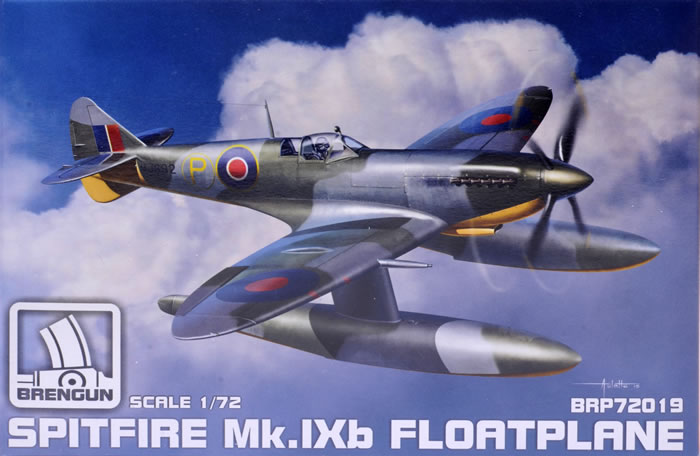
Brengun, 1/72 scale
S u m m a r y : |
Catalogue Number: |
Brengun Kit No. BRP72019 - Spitfire Mk.IXb Floatplane (sic) |
Scale: |
1/72 |
Contents & Media |
42 tan, eight grey, and one clear styrene parts, one PE fret of twelve parts, and decals for one airframe. (A further twenty-five tan parts are spare.) . |
Price: |
Available on-line from these stockists:
Click here for currency converter. |
Review Type: |
First Look. |
Advantages: |
An accurate Spitfire Mk.IX Floatplane, attractively priced, crisply moulded, with fine panel lines, and good detail. |
Disadvantages: |
Undersized wheel-bay blanks. |
Conclusions: |
Finally, we have a decent and complete Spitfire Mk.IX Floatplane kit.
Moreover, it is available at around half the price of a decent float conversion set without a base kit. Brengun have adopted a sensible approach of arranging to supply what was until now probably the best all-round 1/72-scale Spitfire Mk.IX kit* with their floatplane parts.
The kit is only slightly let down by the undersized wheel-bay blanks (something they really should have got right). This niggle is a minor issue when weighed against the positives this kit has to offer.
A must for Spitfire fanatics in ‘The One True Scale’, I recommend this kit highly.
* Eduard’s new Mk.IX has just hit the shops at the time of writing, but I have yet to see one..
|
Reviewed by Mark Davies

Eduard's 1/72 Avia B.534 IV serie Weekend Edition is available online from Squadron.com
With the German invasion of Norway in April 1940 the RAF took an interest in the concept of using floatplane fighters in areas where airfields were not immediately available. To this end a Spitfire Mk I R6722 was taken in hand at the Woolston factory to be modified and mounted on Blackburn Roc floats. Tank tests were carried out at Farnborough, using a 1/7 scale model, it was found that the concept was basically sound, although the vertical tail surfaces would need to be enlarged to counterbalance the side area of the floats. The end of the Battle of Norway and the need for as many Spitfires as possible meant that R6772 was converted back to an ordinary fighter without being flown.
With the entry of Japan into the war the concept was revived in early 1942. A Spitfire V W3760 was fitted with a pair of floats 25 ft 7 in (7.8 m) long, mounted on cantilever legs. This aircraft was powered by a Merlin 45 driving a four-bladed propeller of 11 ft 3 in (3.43 m) diameter (3.4 m). A Vokes filter was fitted to the carburetor air intake and under the tail an extra fin extension was added. Other changes included external lifting points forward of and behind the cockpit and a spin-recovery parachute with a rudder balance-horn guard.
The Spitfire floatplane was first flown on 12 October 1942 by Jeffrey Quill. Soon afterwards the Vokes filter was replaced by an Aero-Vee filter, similar to that on later Merlin 61 series aircraft, which was extended to prevent water entry, and full Mk VB armament was installed. Two more VBs EP751 and EP754 were converted by Folland and all three floatplanes were transported to Egypt, arriving in October 1943. At the time it was thought that the floatplanes could operate from concealed bases in the Dodecanese Islands, disrupting supply lines to German outposts in the area which relied on resupply by transport aircraft. This scheme came to naught when a large number of German troops, backed by the Luftwaffe, took over the British held islands of Kos and Leros.
No other role could be found for the floatplane Spitfires, which languished in Egypt, operating from the Great Bitter Lake. Specifications for the VB based floatplane included a maximum speed of 324 mph (521 km/h) at 19,500 ft (521 km/h at 5,943 m), a maximum rate of climb of 2,450 ft/min at 15,500 ft (12.45 m/s at 4,724 m) and an estimated service ceiling of 33,400 ft (10,180 m).
In the spring of 1944, with the prospect of use in the Pacific Theatre, a Spitfire IX MJ892 was converted to a floatplane. This used the same components as the earlier Mk VB conversions. Jeffrey Quill wrote:
"The Spitfire IX on floats was faster than the standard Hurricane. Its handling on the water was extremely good and its only unusual feature was a tendency to "tramp" from side to side on the floats, or to "waddle" a bit when at high speed in the plane."
Soon after testing started the idea of using floatplane fighters was dropped and MJ982 was converted back to a landplane. Five aircraft were converted:
Source and link to a more complete Spitfire history: Wikipedia.org.
Previous 1/72-Scale Spitfire Floatplane Kits & Conversions
There have been a few attempts at a kit and various float conversions in The One True Scale over the years. Here is what I am aware of, although there are bound to be more.
I know of two complete kits with airframe and floats. Perhaps the best known is the dreadful PM offering using their Spitfire Mk.Vb as a basis, more recently re-boxed by Polyart, and no doubt others. I have heard of people buying the kit just as a float-donor for a more worthwhile airframe, but the floats are far too skinny and generally of doubtful shape. A lesser-known complete floatplane kit was by Korpro (KP), using their MK.IX kit plus floats, replacement tailfin and wheel-well blanks. This kit was once well regarded as possibly the best Mk.IX/XVI in 1/72-scale; but it is now terribly dated and surpassed for accuracy. The floats are completely smooth with no surface detail, and to my eye at least, I think the step is too far back and the rear portion of the floats too short.
I know of three conversion sets. I.D. Models offered a vac-form conversion that had a 3-page article devoted to it in Scale Models magazine of April 1986. Despite the length of the article, the author junked the I.D. floats and modified spare Airfix Ar 96 items instead – Enough said I think! A resin conversion by WTH Model Products (now out of business) was reviewed in Scale Aircraft Modelling magazine of January 2000. The reviewer praised it for research, thoroughness and quality, with an unreserved recommendation – So well done if you have one! The third I am aware of is Mk.IX Floatplane resin conversion by AMC that includes decals and is still available for around US$17.00, although I know nothing of its accuracy. I can recall a friend having another resin set was a copy the dreadful PM kit parts, but cannot recall the brand.
Brengun came to the rescue three years ago with a very good Spitfire Mk.Vb Floatplane kit, reviewed by me here on HyperScale. The kit was very good in no small measure because it include a re-box of AZ Models Spitfire Mk.Vb kit, plus the necessary floats, new rudder, four-blade prop, and wheel-well blanks. Brengun also released a Beaching Gear & PE Cockpit Detail set to compliment their floatplane kit, reviewed by me here on HyperScale.
Possible Misnomer?
Brengun and various histories refer to a Spitfire Mk.IXb Floatplane. As far as I am aware all production Mk.IX’s had either type C or E-wings, never the earlier B-wing.
I have read that the B designation used in conjunction with the Floatplane may be attributable to an unofficial unit-level naming practice of calling LF Mk.IX’s B’s. I believe the Mk.IX Floatplane was based on an LF Mk.IX, so this may explain the common use of the Mk.IXb designation.
Alternatively, the subject of this kit, MJ892, lacked the protruding leading edge cap for the empty cannon bay seen on most C-wings when fitted with the usual single cannon per wing:
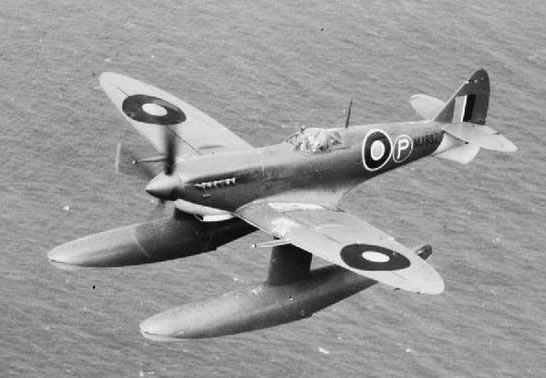
Despite different bulges over the cannon breech than a B-wing, MJ892’s configuration looks much like a B-wing at a glance (see below), and so could offer another explanation for the use of the Mk.IXb designation.
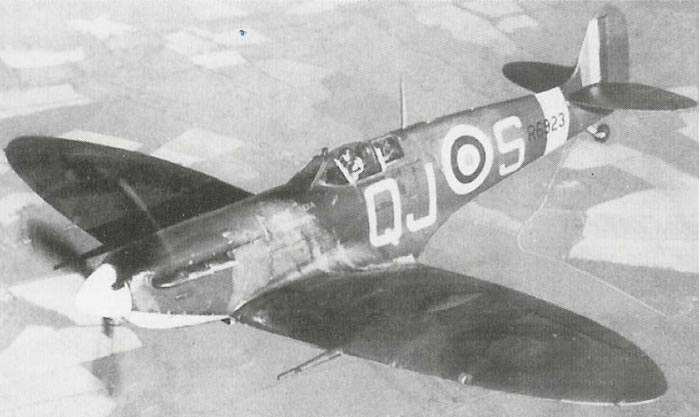
This view would seem to be supported by Spitfire expert, the late Edgar Brooks, who had this to say about missing outer cannon stubs on C-wing Spitfires:
“Regarding missing stubs, on the Spitfire, there was a modification issued, for the V, IX & XII, to "Remove the outboard cannon front mounting casting." I don't have a date for it, and have no idea how many had it, plus it was cancelled mid-November 1943, probably in anticipation of the E armament. That mod could be responsible for so many reports of B wing IXs, I suspect.”
Brengun’s instructions advise to fill the hole in the wing leading edge for the outboard cannon, although their colours & markings incorrectly plan shows the regular cap fitted.
The Contents
The kit comes packed in a small box just big enough for the contents, featuring artwork on the front and a three-view colours & markings guide on its rear.
Three tan and two grey sprues are enclosed within a re-sealable cellophane bag, with the decals, PE fret and clear part further enclosed in a small bag of their own.
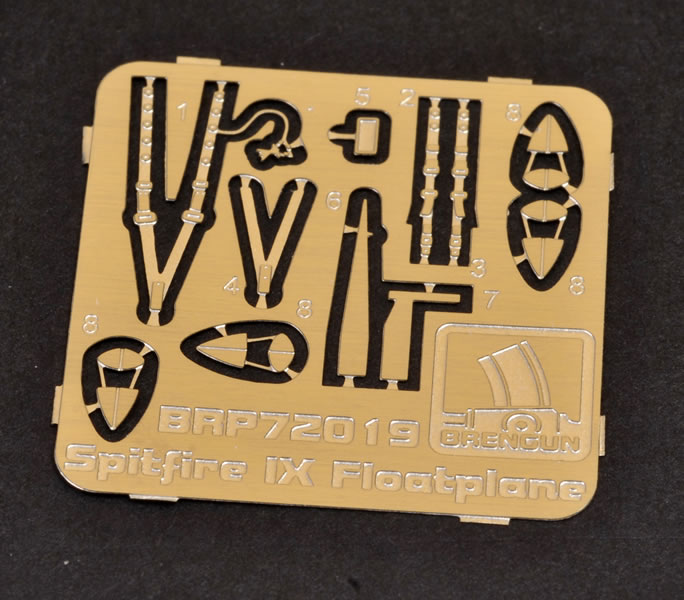
The canopy is supplied in one piece with the sliding section closed.
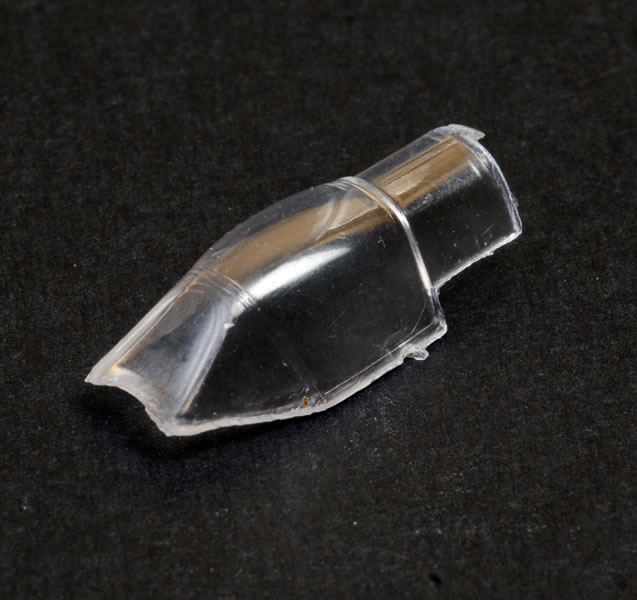
The instructions consist of a single folded A4 sheet giving four pages. They feature a parts map, clear assembly drawings and a stencil placement guide. Test is in English and Czech.
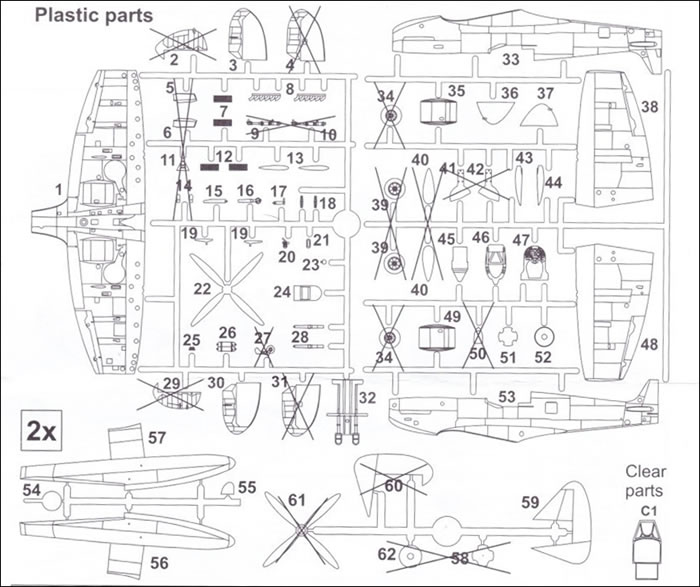
The Base Kit
As with their Mk.Vb Floatplane kit, Brengun has again turned to AZ Model, this time using their excellent Spitfire Mk.IX kit.
I reviewed several boxings of the AZ Model Mk.IX in 2012 here on HyperScale; and in part, concluded at the time:
I think that these are the best injected kits of the Spitfire Mk.IX & XVI available. They are beautifully moulded, have good detail levels, nice decals, and come boxed in a variety packages; all of which offer very good value.
The base kit is generally very accurate, with good cockpit detail, crisp moulding, very fine surface detail, and uses a conventional parts breakdown for the type. The sprue gates are narrow and there is no noticeable flash.
The Floatplane Parts
The floatplane parts consist of a tan sprue providing both the Mk.V and Mk IX floatplane tailfins, and four-blade prop, whilst the two grey sprues supplies the floats and wheel-well blanks. I do not know why the float parts are grey (they were for the Mk.V Flotplane kit too), as I am fairly sure AZ Model and Brengun use the same tool maker and moulding contractor for their aircraft kits.
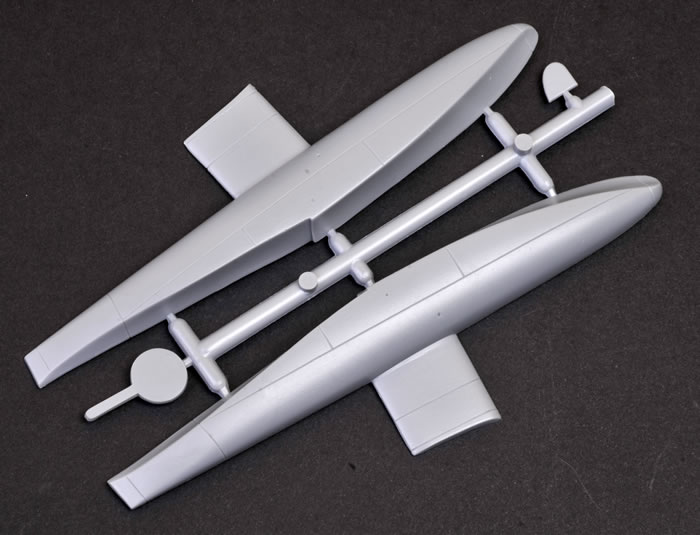
The floats look good to me, as they have a bit of “meat” to them, and the step looks right. They feature some engraved panel-line detail, and separate rudders with PE hinges. I have no plans I can place 100% trust in to compare them to, but they look right compared to period photos.
The float sprue also includes the wheel-well blanking plates, which are undersized. I suggest surrounding their edges five-thou platsicard, or making your own. Just using filler to block the outline gap may not look right, as I assume some kind of outline needs to remain. After all, MJ892 was converted back to a standard Mk.IX land-based fighter after the Spitfire floatplane idea was abandoned. It therefore seems safe to assume the wheel-wells were only blanked off, rather than being fully covered by uninterrupted wing panels.
The other sprue provides the new tailfin and rudder with ventral section. It is necessary to cut away the base kit’s fin. The earlier-style floatplane fin and a spare four-blade prop with spinner are leftovers applicable to the Mk.V floatplane kit.
A small PE fret provides the actuators for floats' rudders, a useful seat harness, and optional replacement underwing pitot and antenna mast.
The instructions advise the distance in from the wingtips to fix the float leg fairings, and show these fairings to be in line with the wing leading edge.
It is probably better to leave the floats off until after painting, although I would check the fit against the wing underside in advance of this. Given that Brengun got the wheel-well blank size wrong, I would not simply trust that they got the float to wing fit right. I recommend a careful check to ensure the floats will sit at the correct angle in relation to the fuselage datum, as there is a risk of getting the floats pointing up or down too much given the curved under-wing surface to which they fix.
Consideration of adding ballast in the aircraft and float noses may be worthwhile to get the model to sit forward on it floats. However, be aware that Brengun offers a resin and PE accessory set that includes beaching wheels, a boarding ladder, and some PE cockpit details; check it out by clicking here.
Here are a couple of Brengun’s images showing the assembled but unpainted model:
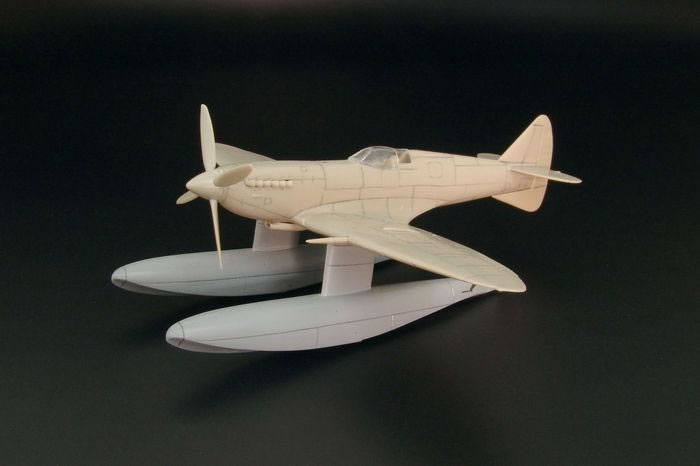
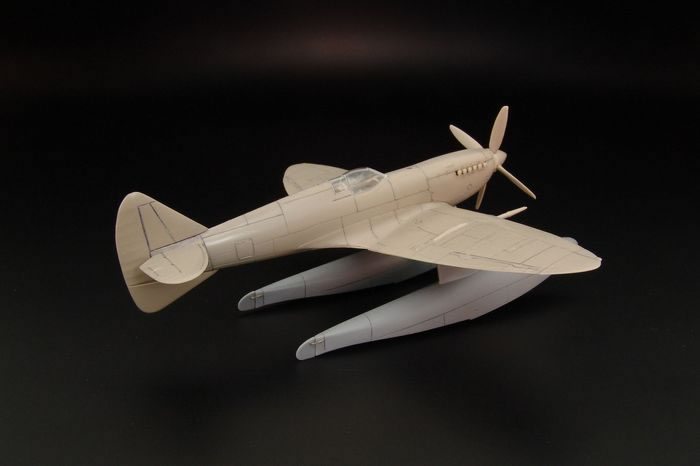
Colours and Markings
Colours and markings are very simple with extra-dark sea-grey and dark slate-grey upper surfaces, Sky spinner, and yellow undersides. They feature have a fairly bright lemon colour whereas I believe that British prototypes wore a darker hue known as Trainer Yellow.
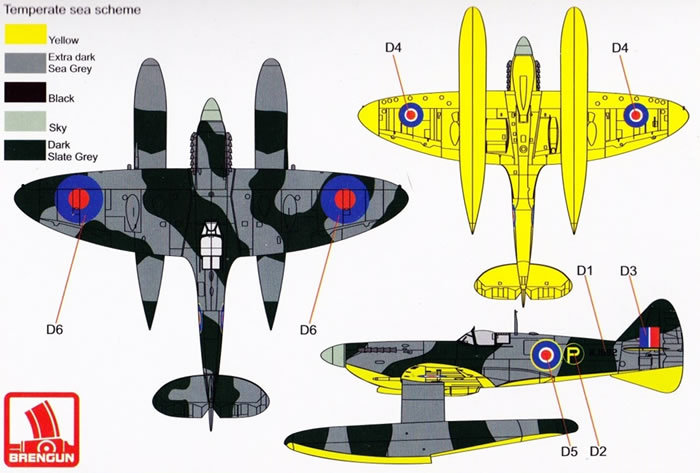
I recommend using this RAF colour from a suitable paint range or mixing it yourself in preference to the shade Brengun illustrates.
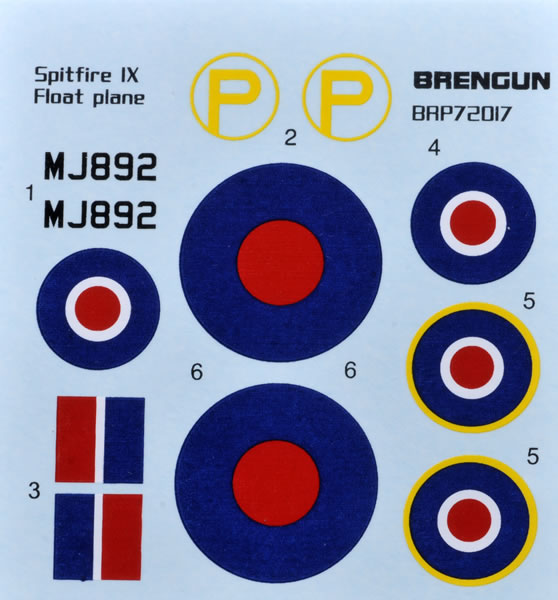
The decals are crisply printed with good registration, and colour density looks good.
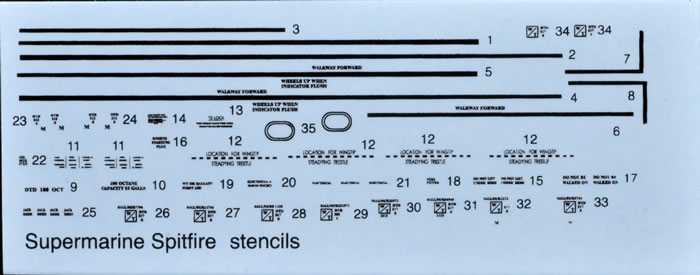
Both the red and yellow may be a tad bright for some, but sourcing replacement roundels should be easy enough if this bothers you, although finding a ringed-P will be less straightforward.
Finally, we have a decent and complete Spitfire Mk.IX Floatplane kit. Moreover, it is available at around half the price of a decent float conversion set without a base kit.
Brengun have adopted a sensible approach of arranging to supply what was until now probably the best all-round 1/72-scale Spitfire Mk.IX kit* with their floatplane parts.
The kit is only slightly let down by the undersized wheel-bay blanks (something they really should have got right). This niggle is a minor issue when weighed against the positives this kit has to offer.
A must for Spitfire fanatics in ‘The One True Scale’, I recommend this kit highly.
* Eduard’s new Mk.IX has just hit the shops at the time of writing, but I have yet to see one.
Thanks to Brengun for the review sample.
Review Text Copyright © 2016 by Mark Davies
Page Created 13 July, 2016
Last updated
13 July, 2016
Back to HyperScale Main Page
Back to Reviews Page |
